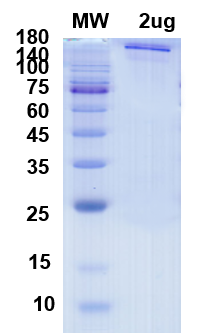Cart (0 Items)
Your cart is currently empty.
View Products



| size | 100ug, 50ug |
|---|---|
| Brand | ProteoGenix |
| Product type | COVID-19 products |
| Host Species | Mammalian cells |
| Product name | SARS-CoV-2 Spike full length, G614 |
|---|---|
| Origin species | SARS-COV2 |
| Expression system | Eukaryotic expression |
| Molecular weight | 136kDa |
| Purity estimated | >90% |
| Buffer | PBS, pH7.5 |
| Form | Liquid |
| Delivery condition | Dry Ice |
| Storage condition | 4°C for short term; -20°c or -80°C for long term |
| Brand | ProteoGenix |
| Host species | Mammalian cells |
| Fragment Type | Full length |
| Reference | PX-COV-P051 |
| Note | For research use only. Not suitable for human use. |
The spike glycoprotein is the most important antigen in the pandemic strain of coronavirus, SARS-CoV-2, the causative agent of the COVID-19 respiratory disease. Containing a complex transmembrane domain and exposed on a trimeric form on the surface of the new virus, the spike protein can be divided into subunits S1 and S2 linked by a furin cleavage site. The S1 subunit contains the receptor-binding domain (RBD) that binds the human receptor ACE2, enriched on the surface of upper respiratory tract epithelial cells. As a consequence, the formation of the RBD-ACE2 complex is known to drive the proteolytic cleavage of the spike, exposing the S2 subunit. As a result, the S2 suffers important molecular rearrangements leading to membrane fusion and virion internalization. To render the spike proteinase-stable, specific single point mutations were made to the furin cleavage linker sequence. In this way, it became possible to express a stable version of the spike with prolonged shelf-life, a crucial change that allows the development of research, diagnostics, and therapeutic applications. The D614G mutation to the spike was first detected in Europe in early March, and it corresponds to a single nucleotide change (G-to-A on position 23,403) that rendered the spike more flexible than the early variant and consequently enhanced its infectivity. Due to its enhanced properties, the variant G614, also known as the “G” clade, became the dominant version of the spike protein in SARS-CoV-2 by the end of March 2020 on a global scale. Further studies revealed the D614G mutation may also enhance not only the stability of virions but also their fitness and replication. This specific version of the spike is monomeric and expressed in Chinese hamster ovary (CHO) cells with high quality and purity. The spike can thus serve as a control for standard detection tests (e.g. ELISA, Flow Cytometry, WB, etc.). Moreover, due to its vital role in the early stages of infection, this protein continues to guide the development of new diagnostic tools, biotherapeutics, and vaccines.
Related products:

Send us a message from the form below
Reviews
There are no reviews yet.